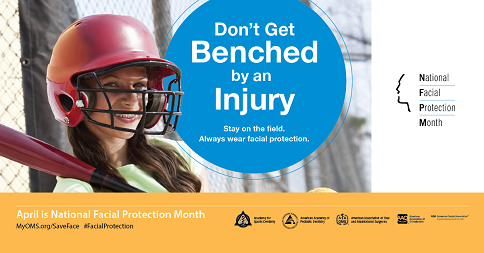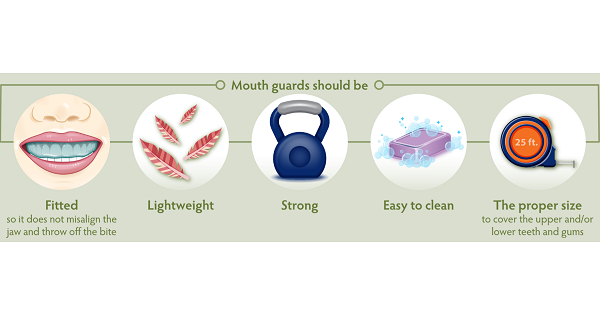
National Facial Protection Month
The Academy for Sports Dentistry, the American Academy of Pediatric Dentistry, the American Association of Oral and Maxillofacial Surgeons, the American Association of Orthodontists and the American Dental Association are teaming up to remind parents, coaches, and athletes, to play it safe when suiting up for recreational and organized sports.
“More than 5 million teeth are avulsed each year; many during sports activities, resulting in nearly $500 million spent on replacing these teeth each year.” – Journal of the American Dental Association
“An estimated 12 million people ages of 5 and 22 years suffer a sport-related injury annually, which leads to 20 million lost days of school and approximately $33 billion in healthcare costs.” – Academy for Sports Dentistry
The National Youth Sports Foundation for Safety reports dental injuries as the most common type of orofacial injury sustained during sports participation, finding that,
“an athlete is 60 times more likely to sustain damage to the teeth when not wearing a protective mouthguard.”
According to the American Dental Association (ADA),
“more than 200,000 oral injuries are prevented each year by wearing a mouthguard.”
Some experts recommend that mouthguards be worn by athletes in competitive and recreational sports in which impact, contact, and collision are likely to occur.
Mouthguards are one of the most important pieces of safety equipment, but they are not required in all sports.
What Sports Require Mouthguards?
Although mouthguards aren’t required in all sports, the American Dental Association (ADA), the American Association of Oral & Maxillofacial Surgeons (AAOMS), and Academy for Sports Dentistry (ASD) recommend wearing custom-fit mouthguards for the following sports:
- acrobatics
- basketball
- biking
- boxing
- cheerleading
- field hockey
- figure skating
- football
- gymnastics
- handball
- hurdling
- ice hockey
- inline skating
- lacrosse
- martial arts
- motocross
- racquetball
- roller hockey
- rugby
- shot put
- skateboarding
- skiing
- skydiving
- soccer
- squash
- surfing
- volleyball
- water polo
- weightlifting
- wrestling
Other experts include baseball and softball infielders on that list. They further recommend the mouthguard to be worn during all practices and competition.
When should you wear a mouthguard?
Anytime you participate in sports!
A good rule of thumb to remember is – when in doubt, use a mouthguard. It’s better to be safe than sorry.
Would you rather spend more money on a custom-fit mouthguard from your dentist or LOTS more money on oral & maxillofacial surgery?
Dental injuries are easily prevented, and it has been suggested that a properly fitted custom mouthguard may reduce the rate of concussion as well as dental injuries.
So why wouldn’t every kid in every sport where a mouth injury is possible, wear one?
“67% of parents admit their child does not wear a mouthguard during organized sports.”
One of the most common complaints coaches, referees, parents & school administrators hear from kids is that the mouthguard is uncomfortable.
When you are fitting your athlete for a mouthguard this season, take note of the fit.
A properly fitted mouthguard should be comfortable allowing for free breathing and speech.
How Should A Mouthguard Fit?
According to the Academy for Sports Dentistry, the fitting of a mouthguard is best accomplished under the supervision or direction of a dentist.
The athlete and/or parents should always be advised of the special design for the “properly fitted mouthguard” and the end product should have the following properties and considerations:
- It should be fabricated to adequately cover and protect both the teeth in the arch, and the surrounding tissues.
- It should be fabricated on a stone model taken from an impression of the athlete.
- Adequate thickness in all areas to provide for the reduction of impact forces. In particular, a minimum of 3mm thickness in the occlusal/labial area.
- It should have a seated equilibrated occlusion that is balanced for even occlusal contact. This helps to provide for the ideal absorption of impact energy.
- A fit that is retentive and not dislodged on impact.
- Speech considerations equal to the demands of the playing status of the athlete.
- A material that meets FDA approval.
The properly fitted mouthguard should be routinely and professionally examined for fit and function.
Frequency of routine inspection is dependent on factors such as the athlete’s age, the demand of the sport that the athlete is engaged in, and the willingness for the athlete to properly care for the appliance.
The frequency of the inspection should be determined by the dental professional for each individual situation and athlete.
5 Criteria For A Properly Fitting Mouthguard
According to the American Association of Oral & Maxillofacial Surgeons, a properly fitted mouthguard should satisfy these five criteria:

1. Secure Fit
A properly fitted mouthguard will allow you to speak, breath, and even drink water without any issue.
You shouldn’t have to clench your teeth to keep your mouthguard in place. A properly fitted mouthguard should remain in place even when getting jostled around due to normal sports activity & impact.
2. Lightweight
The best type of mouthguard is the one you don’t even notice you’re wearing, consider the weight of the mouthguard when attempting to align the proper fit.
3. Strong
You want a mouthguard that will stand the test of rigorous activity, one that is strong and durable.
Low-quality, off-the-shelf mouthguards are neither strong nor durable, meaning you’ll be wasting your money and putting yourself at a higher risk for injury by choosing a weak mouthguard of poor quality.
4. Easy to Clean
In most cases, the types of plastics used to make high-quality athletic mouthguards are both extremely durable and impervious to liquids but they still require proper care.
Regular cleanings – either by soaking or gently scrubbing – are necessary, and you should also have a case or container to prevent damage.
5. Properly Sized
A properly fitted mouthguard will cover all of your teeth and some of your gums, but it should feel like it’s overwhelming your entire mouth.
A mouthguard that’s too short – meaning not covering enough of the tooth’s surface – will leave you at risk for greater injury. But a mouthguard that is too big will most certainly be too uncomfortable to offer optimal protection.
Embed This Infographic On Your Site

How Do You Get The Best Fit From A Mouthguard?
Talk to your dentist about getting a custom-fit mouthguard!
A custom-fit mouthguard from your dentist will offer you the best protection because it is specifically molded to your teeth, gums, and jaw alignment.
Need A Friendly, Affordable Dentist Near You? Find One Now
Sources:


